Australia’s top banks clash on loan buffer rules amid housing shortage
CBA and Westpac say current settings are appropriate as NAB and the ABA call for changes to the serviceability buffer.

Business
Don't miss out on the headlines from Business. Followed categories will be added to My News.
The nation’s largest banks are on opposite sides of an emerging stoush over home loan lending rules, with Westpac and Commonwealth Bank going against peer National Australia Bank and the broader banking lobby in calling for no change to the current settings.
Westpac and CBA on Thursday came out strongly against any changes to the serviceability buffer on home loans, telling a parliamentary inquiry the answer to the housing crisis was not to put more borrowers into debt.
“We believe Australia’s responsible lending and interest rate buffer settings have proven to serve our customers and the country well, particularly as we deal with this inflation repeat over the past two years,” Westpac national general manager for property finance, Martin Green, said.
“We do not believe that banks or the community should have an increasing willingness to accept higher levels of home loan defaults. The 90-day delinquency rate is already higher for first time buyers at 1.23 per cent compared with the average homeowner of 1.1 per cent.
“At the end of these percentages are young Australians who are going to experience hardship in a challenging cost of living environment. We do not think it’s the right to push up our customers’ borrowing capacity to an absolute threshold.”
The serviceability buffer currently requires banks to assess a borrower’s repayment capacity if interest rates rise 3 percentage points higher than the current rate. The Australian Prudential Regulation Authority lifted the buffer to 3 per cent in 2021, when the official cash rate was at an all-time low. The cash rate has since risen to 4.35 per cent.

Like Westpac, CBA argued current regulatory constraints were, on the whole, appropriate and reasonable.
“The (serviceability) buffer is not just for interest rates, but is forward looking across several dimensions, including unforeseen changes in a borrower’s income and expenses,” retail banking boss Angus Sullivan said.
“The data adequately evidences that first-time buyers experience higher levels of mortgage stress, that is true for our portfolio today. They struggle to get into the property market because of the high cost of property and supporting them with more borrowing, in light of (that), is a difficult solution to the problem,” he said, adding that the delinquency rate for first home buyers was double that of the rest of the portfolio.
Warning any change to the prudential settings would heap pressure on home buyers, but acknowledging the difficulties Australians faced getting into the housing market, Westpac stepped further away from its peers in suggesting it may consider waiving lenders mortgage insurance for first home buyers.
“That is a policy rule that we could absolutely consider, and it’s an option available to us,” Mr Green said on the prospect of the bank taking on the risk itself rather than pass it to homebuyers via LMI.

But NAB argued for the prudential regulator to consider changes to the buffer, with chief executive Andrew Irvine telling The Australian: “We are trying to be thoughtful and considered in our response to the debate. The serviceability buffer has played an important role in stability and protecting customers. I also think the (serviceability) buffer could be dynamic not static.”
Mr Irvine was referring to the buffer being adjusted to account for periods of rising interest rates and again in periods when central banks were easing rates.
He said to spur meaningful change in the housing market, on issues such as affordability, policymakers needed to boost the supply of homes.
“If you only tweak demand (side measures) you can make the problem worse.”
Mr Irvine also noted NAB’s position included giving further consideration to lower serviceability buffers for first home buyers and potentially different regulatory arrangements for people with a HECS debt.
NAB executive for home ownership, Andy Kerr, said “all options should be on the table” to increase home ownership among younger Australians.
He said HECS debt was currently double counted in home loan applications: “HECS debt is paid pretax. However, we look at post-tax income as our starting point for serviceability assessment. We are required to consider HECS as a stand-alone debt on top of that, and to some extent, we see that as double counting in its treatment,” Mr Kerr said.
“Our recommendation would be to treat it as it shows up for a customer, which is a deduction pre-tax,” he said.

The major lenders, as well as the ABA, all said increased supply of housing was crucial to help more Australians own a home.
The Australian Banking Association earlier on Thursday urged the prudential regulator to consider a more flexible serviceability buffer on home loans to boost borrowing capacity for first home buyers.
“Existing regulatory guidance should allow more flexibility for lenders to consider a borrower’s future income growth, where it is prudent to do so,” Chris Taylor, chief of policy at the ABA, told the senate economics committee.
“Against an increase in house prices over the past five years, this is an item that does warrant further consideration, and we would support a sensible discussion with APRA on the review of this buffer to make sure it’s appropriate, to ensure that there is a balance and flexibility for first home buyers when considering their application,” he said.
The prudential regulator, meanwhile, said the serviceability buffer exists to ensure that banks lend to borrowers able to repay their loans in a range of scenarios.
It is an “important contingency” for a range of economic shocks, including not just interest rate rises but over the life of the loan, factoring also changes in a borrower’s income or expenses, “which we have seen play out recently as cost-of-living pressures mount,” the regulator said.
Additional reporting: Joyce Moullakis and Valerina Changarathil
More Coverage
Originally published as Australia’s top banks clash on loan buffer rules amid housing shortage









